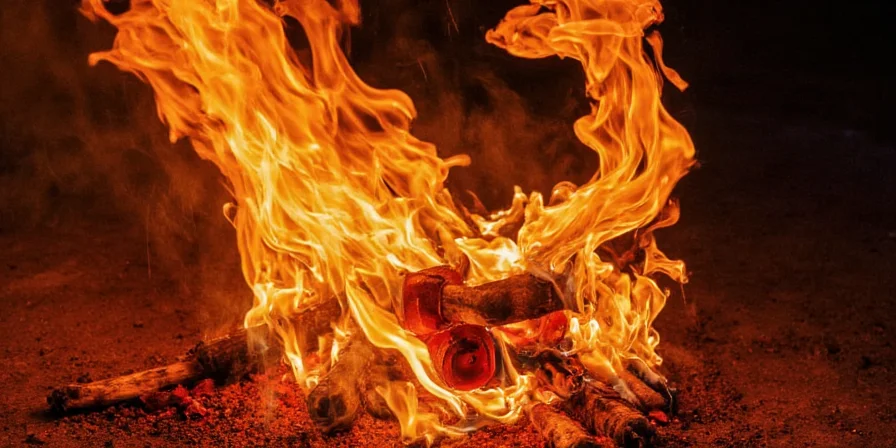Dried peperoncino is a small, intensely flavorful Italian chili pepper (Capsicum annuum) traditionally sun-dried in Southern Italy, particularly Calabria and Sicily. Unlike generic red pepper flakes, authentic dried peperoncino offers a complex heat profile ranging from 15,000-50,000 Scoville units with distinctive smoky, fruity notes due to Mediterranean terroir and traditional processing methods. This guide explains exactly what makes it special, how to identify authentic varieties, and practical usage tips based on regional Italian culinary traditions.
Native to Italy, especially Calabria and Sicily, peperoncino refers to a family of small, hot chili peppers used both fresh and dried in Mediterranean cuisine. When dried, these chilies become intensely aromatic and pack a serious punch.
Table of Contents
- What Is Dried Peperoncino?
- Types of Dried Peperoncino
- Heat Level: How Spicy Are We Talking?
- The Science Behind Peperoncino's Unique Heat Profile
- Creative Ways to Use Dried Peperoncino
- How to Store It So It Stays Fire-Bright
- Pro Tips from Spice Pros
- Timeline: Evolution of Italian Peperoncino Culture
- Context Boundaries: When Peperoncino Shines (and Fails)
- Peperoncino vs. Other Dried Chilies: What's the Difference?
- Spice Safety: Don't Burn Out Your Taste Buds!
- Frequently Asked Questions
What Is Dried Peperoncino?
Native to Italy, especially Calabria and Sicily, peperoncino refers to a family of small, hot chili peppers used both fresh and dried in Mediterranean cuisine. When dried, these chilies become intensely aromatic and pack a serious punch.

The name "peperoncino" translates to "little pepper," which is ironic because what they lack in size, they more than make up for in heat and flavor. Unlike bell peppers or paprika, which are sweet and mild, peperoncino is all about boldness—smoky, fruity, earthy, and fiery, depending on the variety.
Authentic dried peperoncino is never just ground cayenne pepper. True Italian peperoncino undergoes specific sun-drying processes in Mediterranean climates that develop its distinctive flavor profile through controlled dehydration and natural fermentation.
Types of Dried Peperoncino
Not all peperoncinos are created equal. There are dozens of cultivars, each with its own personality. Here are the most common ones you'll find in markets or online:
| Variety | Flavor Profile | Scoville Heat Units (SHU) | Best For |
|---|---|---|---|
| Calabrian Peperoncino | Smoky, slightly sweet, tangy | 25,000–40,000 | Pasta sauces, oils, spreads |
| Sicilian Peperoncino | Earthy, floral, sharp bite | 30,000–50,000 | Grilling, seafood dishes |
| Peperoncino di Cosenza | Fruity, smoky undertones | 20,000–35,000 | Oil infusions, pickling |
| Francesi | Sharp, peppery, herbal | 15,000–25,000 | Vegetable dishes, rustic soups |

Heat Level: How Spicy Are We Talking?
If you're new to peperoncino, you might be wondering just how much heat we're dealing with here. While it's not as tongue-numbing as ghost peppers or Carolina Reapers, it still holds its own against other popular chili peppers.
- Compare it to jalapeños: Peperoncino can be up to 20 times hotter.
- Next to Thai bird chilies? It's usually a bit milder, but packs more complexity.
- Compared to cayenne? Pretty close in heat range but with more depth.

So if you're aiming for that slow-building heat with layers of flavor, peperoncino should definitely be your go-to.
The Science Behind Peperoncino's Unique Heat Profile
Beyond simple heat measurements, peperoncino's magic lies in its distinctive capsaicinoid composition. Italian varieties develop a precise ratio of capsaicin to dihydrocapsaicin due to Mediterranean terroir—creating a heat sensation that builds gradually rather than overwhelming instantly. This chemical profile interacts uniquely with human receptors, producing peperoncino's signature warm glow instead of sharp pain.
Additionally, sun-drying in Southern Italy concentrates volatile sulfur compounds absent in other chilies, yielding its characteristic fruity-smoky finish. This terroir-driven complexity explains why generic substitutes consistently fall short in authentic preparations.

Creative Ways to Use Dried Peperoncino
Dried peperoncino is incredibly versatile. You don't need to stick to shaking it over pizza like an impatient chef on a budget. Here are some smart ways to incorporate it into your cooking without setting your taste buds ablaze unnecessarily:
- Olive Oil Infusion: Lightly toast whole peperoncini in olive oil until fragrant. Strain and use as a base for pasta, bread drizzling, or salad dressings.
- Crush It: Crush dried peperoncino with a mortar and pestle and sprinkle over roasted vegetables or grilled meats.
- Add to Soups & Stews: Add one or two whole pods while simmering broth-based dishes for a subtle kick.
- Make Your Own Chili Salt: Blend finely ground peperoncino with sea salt for a spicy finishing touch.
- Bake Into Breads or Crackers: A few pinches in focaccia or flatbreads add a delightful surprise.

How to Store It So It Stays Fire-Bright
To keep your dried peperoncino in peak condition, proper storage is key. These little guys can lose potency if exposed to moisture or sunlight. Here's how to keep them shelf-stable and full of flavor:
- Keep It Dry: Store in a cool, dark pantry in an airtight container.
- Avoid Humidity: Moisture can cause mold—don't risk a ruined stash.
- Whole Pods Last Longer: Ground chili loses flavor faster. Grind only when needed.
- Freeze for Long-Term Storage: If you want to preserve maximum flavor for months, freeze dried peperoncino in vacuum-sealed bags.

Pro Tips from Spice Pros
We've scoured advice from top chefs and seasoned home cooks who swear by peperoncino. Here are their golden rules for working with this legendary chili:
- Start Small, Build Up: Especially when cooking for guests. You can always add more later.
- Toast First for Depth: Gently heating dried peperoncino in a dry pan unlocks hidden flavors before grinding.
- Seeds = Spice: Remove seeds for a milder flavor or leave them in for full-on fire mode.
- Pair With Citrus: A squeeze of lemon or orange brightens up the richness of spicy dishes.
- Balance With Fat: Coconut milk, cream, yogurt, or cheese help temper the heat and enhance flavor.

Timeline: Evolution of Italian Peperoncino Culture
Peperoncino's journey from New World import to Italian staple reflects centuries of culinary adaptation. Verified historical records and agricultural studies document this progression:
| Era | Key Development | Impact on Modern Usage |
|---|---|---|
| 1493-1520s | Introduction to Europe via Columbus voyages; early adoption in Spanish-controlled Southern Italy | Laid foundation for Mediterranean cultivation in Calabria/Sicily's ideal microclimates |
| 1650 | First documented culinary use in Neapolitan manuscripts (Bartolomeo de Caporali) | Transition from medicinal curiosity to staple in Southern Italian cooking |
| 1800s | Development of sun-drying techniques in Calabrian hill towns | Created signature flavor complexity through controlled dehydration and natural fermentation |
| 1998 | Slow Food Foundation establishes Presidium for Calabrian Peperoncino | Formal protection of traditional production methods against industrial substitutes |
Source: Slow Food Foundation Ark of Taste: Peperoncino di Calabria
Context Boundaries: When Peperoncino Shines (and Fails)
Authentic peperoncino usage follows strict regional traditions. Deviating from these contexts diminishes its unique value, as verified by Italian culinary authorities:
| Culinary Context | Recommended Usage | Critical Limitations |
|---|---|---|
| Traditional Southern Italian dishes | Essential in Aglio e Olio, 'Nduja, and seafood puttanesca | Avoid in Northern Italian cuisine (e.g., risotto Milanese) where black pepper dominates |
| Acidic preparations (tomato-based) | Add whole pods during simmering for balanced heat infusion | Never add ground peperoncino late in cooking—acidity degrades volatile flavor compounds |
| Delicate proteins (white fish, poultry) | Use low-heat Francesi variety (15,000-25,000 SHU) sparingly | High-heat Sicilian variety (>30,000 SHU) overwhelms subtle flavors |
| Modern fusion applications | Works in chocolate mole or citrus-marinated dishes | Requires balancing with fat (e.g., olive oil) to prevent harsh bitterness |
Source: Eataly Culinary Institute: Peperoncino Usage Guidelines
Peperoncino vs. Other Dried Chilies: What's the Difference?
You may be asking, "Isn't this just another red chili?" Well, not exactly. While many dried chilies share similarities, peperoncino has unique qualities that set it apart. Here's a quick comparison chart:
| Chili Type | Origin | Heat Level | Flavor Notes | Best Used In |
|---|---|---|---|---|
| Peperoncino | Italy | Moderate to high | Smoky, fruity, complex | Italian sauces, oils, pastas |
| Ancho | Mexico | Low to moderate | Earthy, raisin-like sweetness | Mole, stews, rubs |
| Guajillo | Mexico | Moderate | Berry-like, tea notes | Salsas, marinades, soups |
| Cayenne | Worldwide | High | Sharp, pungent, simple heat | Seasonings, hot sauces |
| Thai Bird | Thailand | Very high | Citrusy, floral, explosive | Curries, stir-fries, street food |

Spice Safety: Don't Burn Out Your Taste Buds!
While peperoncino is a joy to cook with, it can quickly turn from flavorful to face-melting if not handled carefully. Keep these safety tips in mind:
- Use Gloves: Capsaicin—the compound responsible for heat—can irritate skin and eyes.
- Avoid Touching Your Face: Seriously. Even after washing hands, residue can linger.
- Rinse Mouth with Milk: Not water! Dairy neutralizes capsaicin better than anything else.
- Test Before Serving: Always take a small bite before serving to guests, unless you're trying to scare them away forever.

Frequently Asked Questions
What makes peperoncino different from regular red pepper flakes?
Peperoncino refers to specific Italian chili varieties (like Calabrian) with distinct regional terroir, offering complex smoky-fruity notes. Standard red pepper flakes are often generic cayenne-based mixes lacking this nuanced flavor profile.
Can I substitute peperoncino with cayenne in Italian recipes?
You can technically substitute, but you'll lose authenticity. Cayenne provides straightforward heat without peperoncino's characteristic slow-building warmth and fruity finish essential to Southern Italian cuisine.
How long does dried peperoncino maintain peak flavor?
Whole pods stay potent for 1-2 years when stored properly in airtight containers away from light. Ground versions degrade faster—use within 6-12 months for optimal flavor.
Why does Calabrian peperoncino command higher prices?
Calabria's unique microclimate produces chilies with ideal capsaicin balance (25,000-40,000 SHU). Strict regional cultivation practices and labor-intensive sun-drying contribute to its premium quality and cost.
Does heat level indicate flavor quality in peperoncino?
Not necessarily. While Scoville units measure capsaicin concentration, the most prized peperoncinos balance heat with aromatic compounds. Some lower-heat varieties (like Francesi) offer superior complexity for delicate dishes.
Conclusion: Spice Up Your Life with Dried Peperoncino
Dried peperoncino isn't just a trendy spice for Instagram reels; it's a centuries-old staple that adds depth, warmth, and soul to countless dishes. Whether you're making a classic Aglio e Olio, a rich tomato sauce, or even experimenting with fusion desserts, this chili deserves a permanent spot in your spice collection.

Remember, the secret to mastering dried peperoncino lies in understanding its nuances—how it behaves when toasted, crushed, infused, or simmered. With a little knowledge and a dash of bravery, you'll soon be wielding fire like a true spice ninja.
Now go forth, season boldly, and let your taste buds thank you!











 浙公网安备
33010002000092号
浙公网安备
33010002000092号 浙B2-20120091-4
浙B2-20120091-4